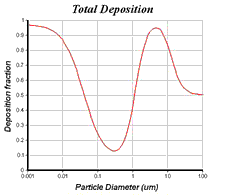Respiratory Deposition |
Home | < PREV | NEXT > |
:: Section 5
Total Deposition
A particle entering our respiratory system is subject to all the deposition mechanisms described previously. The actual deposition efficiency of a given particle size has been determined experimentally. Several models have been developed to predict the deposition based on experimental data. Two advanced and widely used ones are those developed by the International Commission on Radiological Protection (ICRP) and the National Council on Radiation Protection and Measurement (NCRP). The total deposition fraction (DF) in the respiratory system according to ICRP model is

where dp is particle size in μm, and IF is the inhalable fraction defined as

The entry of aerosols into the mouth or nose is affected by the human head that distorts the airflow approaching the mouth or nose (i.e. inhalability). The impact is greater on larger particles (> 3 μm) and hence their actual entry efficiency is reduced.
The total deposition fractions considering inhalability are shown in the plot below. Large particles have a high deposition fraction due to impaction and settling. The fraction decreases for particles larger than 3μm is due to the reduced entry into the mouth or nose. Small particles also get a high deposition fraction due to diffusion. The minimum efficiency is between 0.1 and 1.0 μm, where none of the above mechanisms dominates.

Now provide a particle size and get its total deposition fraction